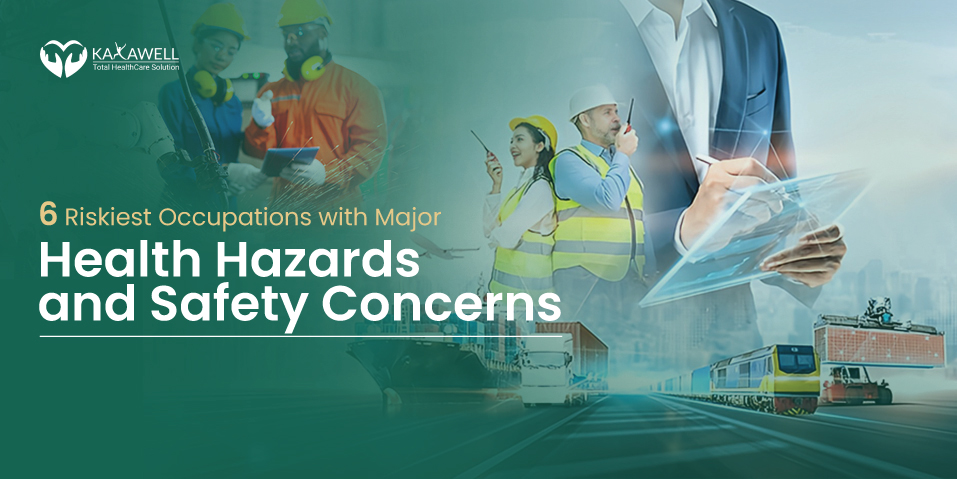6 Riskiest Occupations with Major Health Hazards and Safety Concerns
Today, ensuring occupational safety and health is crucial as we work to protect the well-being of workers in various industries. Despite safety and technology advancements, nearly 3 million people die annually from work-related accidents and diseases. Though all jobs have risks, some professions are especially hazardous, posing substantial health hazards and safety concerns for workers.
Jobs ranging from high-rise construction to emergency response face challenges that can significantly affect physical and mental health. While these high-risk occupations are demanding, understanding the importance of safety is crucial, just like recognizing what are the benefits you will get from physical exercise activity. In this article, we explore six high-risk occupations, focusing on the major health hazards and safety concerns these demanding roles face
1. Construction Workers
Construction work is one of the most dangerous professions due to its inherent risks and dynamic environment. A study published by Science Direct found that construction workers are 5.57 times more likely to be killed in US workplaces. This significant risk highlights the extreme dangers faced by those in the construction industry.
Workers in this field face numerous health hazards, such as falls from heights, scaffold collapses, and being struck by heavy machinery. The use of powerful tools and equipment heightens risks, while exposure to hazardous materials such as asbestos and lead can cause long-term health issues. Additionally, the job’s physical demands frequently result in chronic pain and musculoskeletal disorders.
To reduce these risks, strict safety protocols, ongoing training, and PPE are essential. However, construction workers still encounter considerable dangers despite these precautions.
How can construction workers minimize exposure to hazardous materials?
Construction workers can reduce exposure to hazardous materials by using proper personal protective equipment (PPE) and adhering to safety protocols. Ensuring good ventilation and regularly updating safety training are also essential. Conducting thorough risk assessments and following guidelines for handling and disposing of hazardous substances further minimizes exposure.
2. Mining Workers
Mining is among the most hazardous occupations, fraught with significant health risks and safety concerns. Bloomberg reported in 2023 that over three dozen workers died in mining accidents last fiscal year, marking a 31% increase. The top mine safety enforcer at the US Labor Department described this rise as “troubling”.
Workers in this field face dangers such as cave-ins, explosions, and exposure to toxic substances like silica dust and diesel fumes. Long-term exposure to these substances can lead to chronic respiratory conditions, including pneumoconiosis and chronic obstructive pulmonary disease (COPD). Also, the physical strain of mining can lead to musculoskeletal injuries.
What advancements have been made in mining safety?
Advancements in mining safety include enhanced ventilation systems, improved personal protective equipment (PPE), and automated machinery. Real-time monitoring technologies, along with increased data analytics and safety training, further reduce hazards and prevent accidents.
3. Agricultural Workers
Agricultural work is fraught with health hazards and safety risks due to the nature of the tasks involved. Workers are exposed to a range of dangers, including heavy machinery, toxic pesticides, and extreme weather conditions. Injuries from machinery accidents, respiratory issues from pesticide inhalation, and heat-related illnesses are common concerns.
The University of Illinois Urbana-Champaign found that vehicles, including tractors and ATVs, were the leading cause of injuries. Over 55,000 incidents were reported from these vehicles. Other major causes were machinery, slips and trips, animals, chemicals, and tools, with men over twice as likely to be injured.
Extended exposure to dangerous chemicals can cause chronic health issues like cancer and respiratory diseases. Additionally, the physical demands of farm work often lead to persistent pain and musculoskeletal injuries. To mitigate these risks, it is essential to implement safety measures, including protective gear, adequate training, and regular health assessments.
4. Firefighters
Firefighting is one of the most perilous professions, exposing workers to numerous health hazards and safety concerns. Firefighters contend with extreme heat, smoke inhalation, and the physical demands of emergency response. They are also at risk of burns, falls, and injuries from heavy equipment.
Beyond the immediate risks, firefighters are also facing long-term health concerns. A growing body of evidence suggests a correlation between firefighting and certain types of cancer. This has led to increased scrutiny of the chemicals used in firefighting equipment and at fire scenes.
A major concern is the health impact of firefighting foam (AFFF), which contains harmful PFAS chemicals associated with long-term health issues. TorHoerman Law highlights that PFAS are synthetic chemicals that persist in the environment and are associated with serious health risks. These include reproductive issues, kidney and liver damage, and various cancers.
Many firefighters are involved in ongoing legal battles over these chemicals, with numerous lawsuits filed against manufacturers of firefighting foam. The firefighting foam lawsuit alleges that exposure to these chemicals has led to serious health problems, including cancers and other chronic conditions. The subsequent lawsuits highlight the need for stricter regulations and safer alternatives to protect both firefighters and the public.
What steps can firefighters take to minimize health risks associated with AFFF firefighting foam?
Firefighters can reduce health risks from AFFF foam by using non-toxic agents, following strict decontamination procedures, and wearing protective equipment. Regular health screenings and proper disposal of contaminated materials also help in mitigating long-term health effects.
5. Logging Workers
Logging is one of the most hazardous occupations, presenting severe health risks and safety concerns. Workers in this field face dangers such as falling trees, heavy machinery, and rugged terrain. Common injuries include fractures, crush injuries, and lacerations. Logging also exposes workers to respiratory issues caused by inhaling dust and wood particulates
Effective safety measures, such as wearing PPE, proper training, and following strict safety protocols, are crucial for minimizing these risks.
6. Healthcare Workers
Healthcare workers face significant health hazards and safety concerns due to the nature of their work environment. They are exposed to various risks, including infectious diseases, needle-stick injuries, and exposure to hazardous chemicals. The job’s physical demands, including patient lifting and long hours, can result in musculoskeletal injuries and chronic pain.
Also, healthcare workers frequently face high burnout and stress, affecting their cognitive health.
Prioritizing Safety in High-Risk Professions
Occupational safety is crucial, especially in high-risk professions with severe hazards and substantial health risks. Understanding and addressing these risks with improved safety practices, better protective equipment, and ongoing health monitoring enhances workers’ well-being in challenging fields.
Prioritizing safety reduces injuries and health issues, fostering a sustainable, supportive work environment for those who keep our world functioning.

